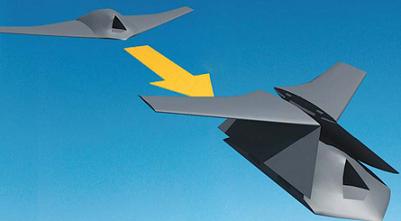The American Air Force will soon fulfill its dream - an airplane whose shape of wings changes completely while in flight.
Popular Sciences

Changing the shape of the wing in flight
Performing a reconnaissance flight in an F-16 fighter jet is about as efficient as driving a Formula 1 race car to the grocery store. The swept back wings provide great maneuverability at high speed, but in order to hover for hours at a time it is better to choose a slow plane with straight wings such as the unmanned spy plane of the US Air Force, Global Hawk. However, what do you do if you need to scan large areas of land and react instantly to the enemy's activity? The ideal solution is reminiscent of a bird's wings - a wing that can be completely changed in size, shape and position on command. The problem is, such an airplane wing does not exist. At least by the hour.
Skunk Works of Lockheed Martin and Next-Gen Aeronautics - two companies that won tenders from the Defense Advanced Research Projects Agency (DARPA) last year - are designing, in collaboration with the US Air Force Research Laboratory, wings whose entire surface area changes by up to 150% due to A single click of a switch. Models of the wings designed by the contracting companies, on a 1:2 scale, will be tested later this year in a wind tunnel at NASA's research center. If the design of one of the wings is found to be aerodynamically efficient, DARPA will authorize the construction of a full-size unmanned prototype of the entire aircraft, with a wingspan of 6 to 9 meters.
A mechanical change of the shape of the wings was carried out back in the days of the Wright brothers and is still carried out today in many planes, including the B1-B bomber - but in most cases it is a rigid design and movement back and forth on a simple axis. However, new polymers that contract and expand when an electric current is applied allow engineers to create a highly flexible shell that stretches along with folding actuators integrated into the wings.
One way to change the shape of the wings is the origami method. Lockheed Martin's Skunk Works uses heat-sensitive polymers instead of aluminum so that the skin of the wing can be made flexible or rigid in an instant. The actuators integrated into the wing act as joints and bend it in order to adapt its shape to the flight pattern. The actuators are made from strips of thermal polymer that expands in response to heat and creates torque. The wings fold towards the body at the various joints, and are able to turn a spy plane - when they are straight, into a fighter plane - when they are folded, while flying. The total change in the wing key exceeds 50 percent.
A DARPA spokeswoman said that no long-term plans for the technology have been made at this time. According to her, "decisions will be made in the future - after we learn the results of the current phase". However, the US government's investment of $19 million indicates a certain faith in the future of military technology.
To register for Popular Science - special offers for surfers of the science website
The aviation connoisseur
https://www.hayadan.org.il/BuildaGate4/general2/data_card.php?Cat=~~~361315205~~~142&SiteName=hayadan
